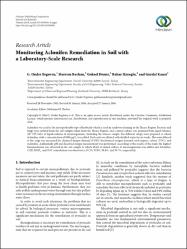Monitoring Aclonifen Remediation in Soil with a Laboratory-Scale Research
Abstract
Aclonifen was used as the most preferable type of herbicide which is used in sunflower farming in the Thrace Region. Bacteria and fungi were isolated from the soil samples taken from the Thrace Region, and a mixed culture was prepared from equal volumes (10(8) CFU/mL) of liquid cultures of microorganisms. Including the witness sample, five different setups were prepared, to which Aclonifen, with a concentration of 1900 mu g/L, was added. Each unit was diluted with distilled water for six weeks. The water filtered at this stage was measured for chemical oxygen demand (COD), biochemical oxygen demand, total organic carbon (TOC), and Aclonifen. Additionally, pH and dissolved oxygen measurement was performed. According to the results of the study, the highest bioremediation was observed in the soil sample to which 10 mL of mixed culture of microorganisms was added and Aclonifen, COD, BOD5, and TOC remediation was observed as 93.2%, 97.8%, 98.8%, and 98.7%, respectively.



















